|
|
| ||||||||
A Family Project
Building a
Twin Power Reverb
Guitar Amplifier
By Pete B. Feb. 2006
Cabinet with Speakers Completed - April 23, 2006
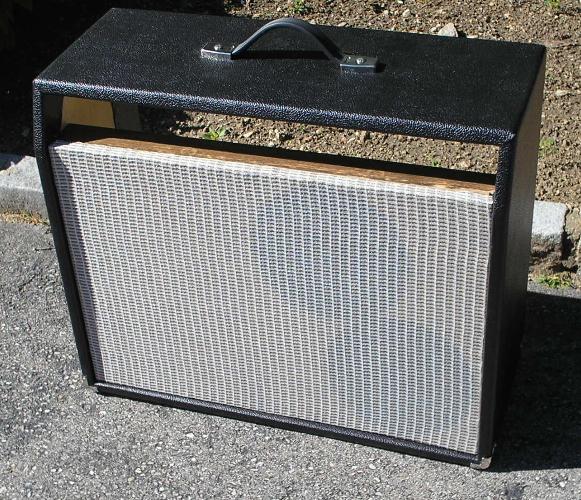
Amp Cabinet started - February 22, 2006:
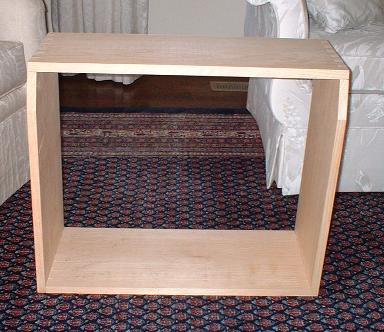
I'm an engineer with a lot of audio and loudspeaker design experience but I've never built a guitar amp. However, I have taken a look at many guitar amp schematics and speaker parameters over the years. I suggested the Fender Twin Reverb because of its legendary status. Here is a link to an excellent web site covering the history and many details about Fender products. This page offered extensive information about how Fender amplifier cabinets were constructed and which guitar speakers were used.
I suggested a faithful copy, but Paul suggested that we be creative and do our own thing. Our plan is to base it on the Fender Twin Reverb design, make our own changes, and we can always back up and copy the original if we do not like the results.
What makes even more sense for the bass section (run undistorted) is to use a 300 to 500 W solid state amp to drive a long throw rugged woofer with a Linkwitz-Transform to compensate for the small box. This probably would not work very well if the intent is to distort the bass section. This is beyond the scope of this project.
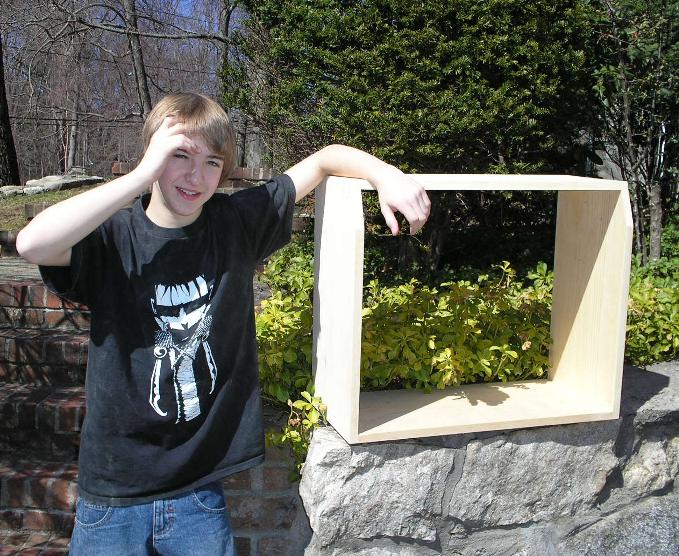
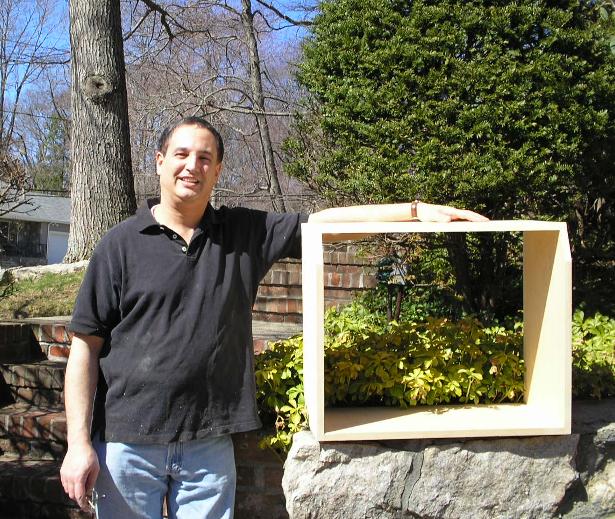
Background
- The Fender Twin Reverb
The Fender Twin Reverb was produced for many years starting in the 1950s. The 80 watt "Black Face" Twin Reverb which had a black front panel, silver lettering, and black tolex covering came out in the early 1960s and was produced with several different speakers over the years. The twin designation referred to the use of two 12" speakers.
The most popular speaker in the early days was the ALNICO Jensen with a 1" voice coil (P12N) and other speakers such as the Oxford T rated 12" were also used in the Twin over the years. The 1965 Twin used an Eminence 12" that was designed to emulate the Jensen C12N. JBL speakers were available as an upgrade when purchasing a Fender Twin. The C12N ceramic version of the Jensen P12N was used in later years. It's said that the Twin (80W) could "easily shread" a pair of Jensens and the Oxfords were not much better. I expected this from speakers with a 1" voice coil, and it seems that the latest Eminence speaker often used in reissues as a replacement for the C12N have a 1.5" voice coil wound on a Kapton former offering much better power handling. I've heard that many professionals prefer the Pro Reverb which is very similar but used four 10" woofers instead. This makes a lot of sense since dividing the power over four voice coils makes for a much more rugged system.
The power went up over the years in the silver face versions first to 100W then to 135W by increasing the supply voltage to the power amp. These designs grossly stressed the output tubes and were known to "eat" tubes fast, low quality 6L6GCs often fail instantly.
The Twin Reverb is an economical design but was engineered for performance where it made a difference. The preamp section used the very popular 12AX7 family hi-mu twin triode tube but the better 7025 version was used where it's low noise and low microphonic characteristics made a difference. Two input channels were provided one with reverb and tremelo and the other, a straight "clean" channel. The power amp is a simple 6L6GC push-pull parallel design with a differential (long tail pair) 12AT7 driver. The early black face ran the output tubes in pure pentode mode with a capacitor filtered screen grid supply. The later 135W version is an ultra-linear design with the required taps on the output transformer driving the screen grids.
The most popular, and most collectable was the "Black Face" Fender Twin Reverb and this makes sense since the increased power simply stressed the design beyond what the tubes could tolerate.
There's a very similar version with four 10" speakers and this makes a lot of sense since the power is distributed over four voice coils which should provide much better reliability. I had not looked into details about the speakers until after we had chosen and started construction of the box, and therefore it was too late to do the model with four 10" speakers. There also happen to be 10" and 12" Alnico drivers available from Eminence and in looking at the specs the 10" is better suited to the open back cabinet in my opinion, used four at a time of course.
Box Construction
I read about the construction and saw that the early Fender boxes were made from pine and employed finger joints. Paul and I spent some time sifting through the better grade 12" X 3/4" X 8' pine shelving at Home Depot, until we found a nice clean piece. I chose the dimensions to use the entire piece which turned out to be about 1" bigger than the original Fender model. We did the cutting and construction in Dad's workshop making this a family project. He had a dado blade from many years ago which is what's needed to make the finger joints. Here we are making the dado cuts:
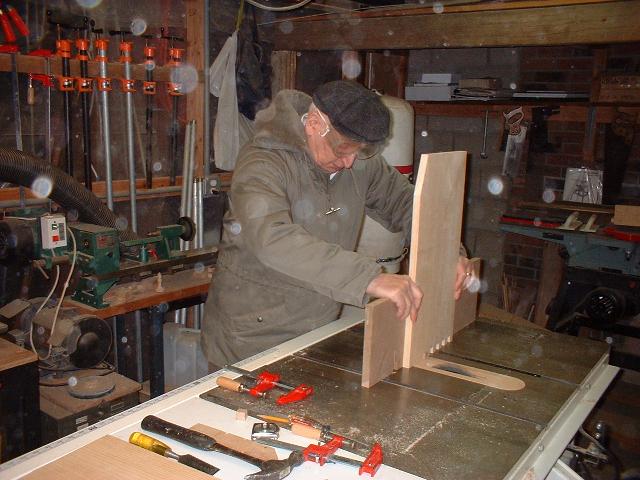
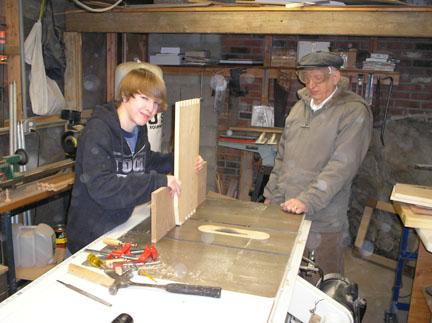
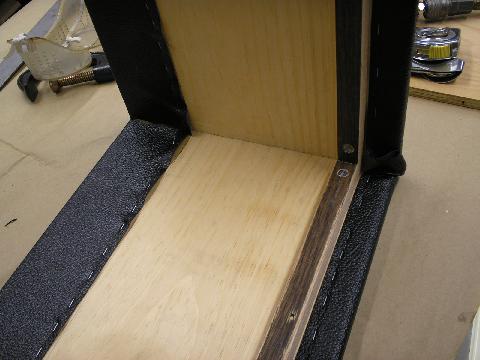
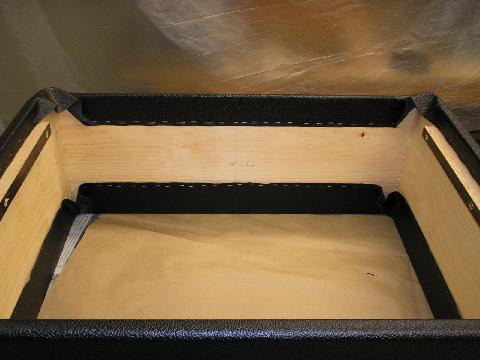
The Baffle Mounting Frame is made from 3/4" Oak Wood
And a Similar Frame Will be Installed in the Back Over the Tolex
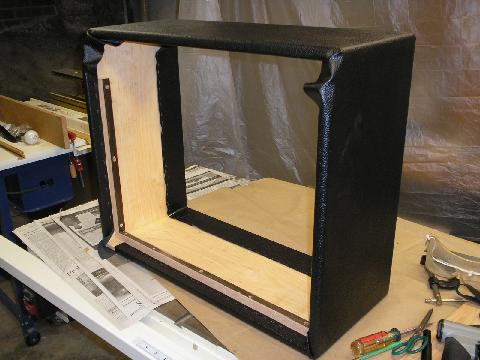
I have a lot to say about speakers but it will have to wait. I had a pair of very nice light paper cone SEAS 8" woofers, which have good specs for a guitar amp except for the low Fs. These drivers are about 20 years old and the foam was rotting. We needed to stiffen the suspension anyway, to raise Fs, so we coated the surrounds with PVA glue. This actually worked very well with the foam acting as a sponge for the glue. We're going to measure Thiele and Small parameters and go from there. The correct surrounds are not available and we'll adapt 8" foam replacements for common drivers if these do not hold up.
There's room for a 12" and that will come later, it's plenty loud as it is for now.
I'll just mention that these open back cabinets are essentially dipole type speakers, which typically require huge volume displacement (VD) and equalization to provide deep bass. Sound reinforecment and musical instrument speakers are the complete opposite usually having very low volume displacement. On the other hand, a pair of 12" drivers is a lot for that small box so this factor does somewhat offset the VD requirement.
It is interesting that Marshall typically uses closed box enclosures which are also not a very good fit for these light cone low VD drivers which results in a high Fc and limited low frequency MaxSPL capability.
A vented enclosure is the best match for light cone low VD drivers because the output is augmented by the vent.
© 2006 Pete B. All Rights Reserved
Building a
Twin Power Reverb
Guitar Amplifier
By Pete B. Feb. 2006
Cabinet with Speakers Completed - April 23, 2006

Amp Cabinet started - February 22, 2006:

Introduction
This
project has evolved from our older son's interest in building a guitar
amp. He has the Squire Strat copy authorized by Fender.
His is actually well built with very good fit and finish - it must have
been a good day when it was built. He also has a few small practice
amps.I'm an engineer with a lot of audio and loudspeaker design experience but I've never built a guitar amp. However, I have taken a look at many guitar amp schematics and speaker parameters over the years. I suggested the Fender Twin Reverb because of its legendary status. Here is a link to an excellent web site covering the history and many details about Fender products. This page offered extensive information about how Fender amplifier cabinets were constructed and which guitar speakers were used.
I suggested a faithful copy, but Paul suggested that we be creative and do our own thing. Our plan is to base it on the Fender Twin Reverb design, make our own changes, and we can always back up and copy the original if we do not like the results.
Our
Twin Power Concept
We're calling this a
Twin Power Reverb because it will have the same two channel preamp with
reverb as the original Fender, but it will also have a two channel power
amp. The plan is to have one power amp channel drive speakers (two
8" probably) better suited for normally tuned 6 string playing, and the
other drive a large speaker (probably a 12") better suited for the bass
range associated with down tuning the guitar. We're doing this
because we have a pair of output transformers that we want to use, and we
noticed that many of the top pro guitar players are playing through both
lead and bass guitar amps. I did a search after thinking of this
idea and it has been done before in the 1960s, at least the two power amp
channels.What makes even more sense for the bass section (run undistorted) is to use a 300 to 500 W solid state amp to drive a long throw rugged woofer with a Linkwitz-Transform to compensate for the small box. This probably would not work very well if the intent is to distort the bass section. This is beyond the scope of this project.
Paul
and Cabinet Just After Sanding

Here I
am With the Cabinet

The cabinet looked so nice after
sanding that it seemed to be a shame to cover it with Tolex. The
pictures are before we used a router with a round over bit to provide
rounded edges.
The Fender Twin Reverb was produced for many years starting in the 1950s. The 80 watt "Black Face" Twin Reverb which had a black front panel, silver lettering, and black tolex covering came out in the early 1960s and was produced with several different speakers over the years. The twin designation referred to the use of two 12" speakers.
The most popular speaker in the early days was the ALNICO Jensen with a 1" voice coil (P12N) and other speakers such as the Oxford T rated 12" were also used in the Twin over the years. The 1965 Twin used an Eminence 12" that was designed to emulate the Jensen C12N. JBL speakers were available as an upgrade when purchasing a Fender Twin. The C12N ceramic version of the Jensen P12N was used in later years. It's said that the Twin (80W) could "easily shread" a pair of Jensens and the Oxfords were not much better. I expected this from speakers with a 1" voice coil, and it seems that the latest Eminence speaker often used in reissues as a replacement for the C12N have a 1.5" voice coil wound on a Kapton former offering much better power handling. I've heard that many professionals prefer the Pro Reverb which is very similar but used four 10" woofers instead. This makes a lot of sense since dividing the power over four voice coils makes for a much more rugged system.
The power went up over the years in the silver face versions first to 100W then to 135W by increasing the supply voltage to the power amp. These designs grossly stressed the output tubes and were known to "eat" tubes fast, low quality 6L6GCs often fail instantly.
The Twin Reverb is an economical design but was engineered for performance where it made a difference. The preamp section used the very popular 12AX7 family hi-mu twin triode tube but the better 7025 version was used where it's low noise and low microphonic characteristics made a difference. Two input channels were provided one with reverb and tremelo and the other, a straight "clean" channel. The power amp is a simple 6L6GC push-pull parallel design with a differential (long tail pair) 12AT7 driver. The early black face ran the output tubes in pure pentode mode with a capacitor filtered screen grid supply. The later 135W version is an ultra-linear design with the required taps on the output transformer driving the screen grids.
The most popular, and most collectable was the "Black Face" Fender Twin Reverb and this makes sense since the increased power simply stressed the design beyond what the tubes could tolerate.
There's a very similar version with four 10" speakers and this makes a lot of sense since the power is distributed over four voice coils which should provide much better reliability. I had not looked into details about the speakers until after we had chosen and started construction of the box, and therefore it was too late to do the model with four 10" speakers. There also happen to be 10" and 12" Alnico drivers available from Eminence and in looking at the specs the 10" is better suited to the open back cabinet in my opinion, used four at a time of course.
Box Construction
I read about the construction and saw that the early Fender boxes were made from pine and employed finger joints. Paul and I spent some time sifting through the better grade 12" X 3/4" X 8' pine shelving at Home Depot, until we found a nice clean piece. I chose the dimensions to use the entire piece which turned out to be about 1" bigger than the original Fender model. We did the cutting and construction in Dad's workshop making this a family project. He had a dado blade from many years ago which is what's needed to make the finger joints. Here we are making the dado cuts:
Dad
(Louis) Demonstrating How to Make the Dado Cuts
Papou (Grandpa in Greek) to our boys
Papou (Grandpa in Greek) to our boys

Paul
Takes Over the Cutting

Covering the Pine
Box
I purchased the Tolex (black covering
material), chrome metal corner parts, and a handle from Parts Express.
Most of these supplies were on sale. The standard procedure is
to glue on the Tolex but I've had some experience redoing automotive
coverings with staples, and decided to try stapling on the material.
Here are some pictures as I did the job:


The Baffle Mounting Frame is made from 3/4" Oak Wood
And a Similar Frame Will be Installed in the Back Over the Tolex

The
Completed Box


Taking our Time
to Complete the Amplifier
We're going to enjoy the process of building this amp, which means we're not going to rush to finish it. I have a Dynaco Stereo 70 amp that Paul can use driven from the line out of one of his other guitar amps.
We're going to enjoy the process of building this amp, which means we're not going to rush to finish it. I have a Dynaco Stereo 70 amp that Paul can use driven from the line out of one of his other guitar amps.
I have a lot to say about speakers but it will have to wait. I had a pair of very nice light paper cone SEAS 8" woofers, which have good specs for a guitar amp except for the low Fs. These drivers are about 20 years old and the foam was rotting. We needed to stiffen the suspension anyway, to raise Fs, so we coated the surrounds with PVA glue. This actually worked very well with the foam acting as a sponge for the glue. We're going to measure Thiele and Small parameters and go from there. The correct surrounds are not available and we'll adapt 8" foam replacements for common drivers if these do not hold up.
There's room for a 12" and that will come later, it's plenty loud as it is for now.
I'll just mention that these open back cabinets are essentially dipole type speakers, which typically require huge volume displacement (VD) and equalization to provide deep bass. Sound reinforecment and musical instrument speakers are the complete opposite usually having very low volume displacement. On the other hand, a pair of 12" drivers is a lot for that small box so this factor does somewhat offset the VD requirement.
It is interesting that Marshall typically uses closed box enclosures which are also not a very good fit for these light cone low VD drivers which results in a high Fc and limited low frequency MaxSPL capability.
A vented enclosure is the best match for light cone low VD drivers because the output is augmented by the vent.
© 2006 Pete B. All Rights Reserved